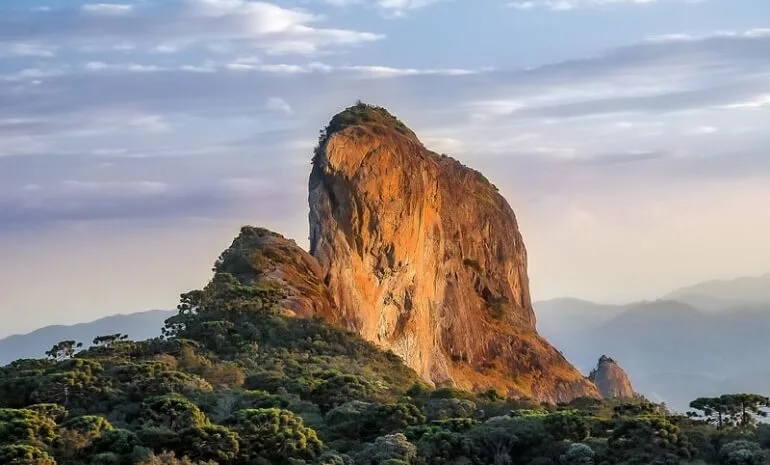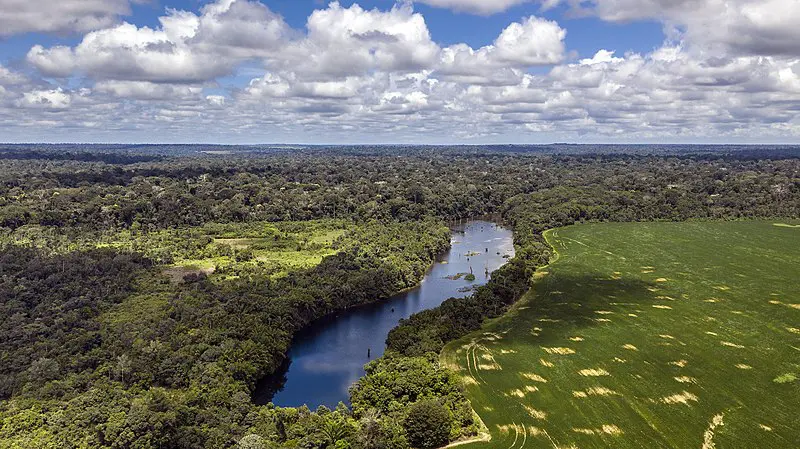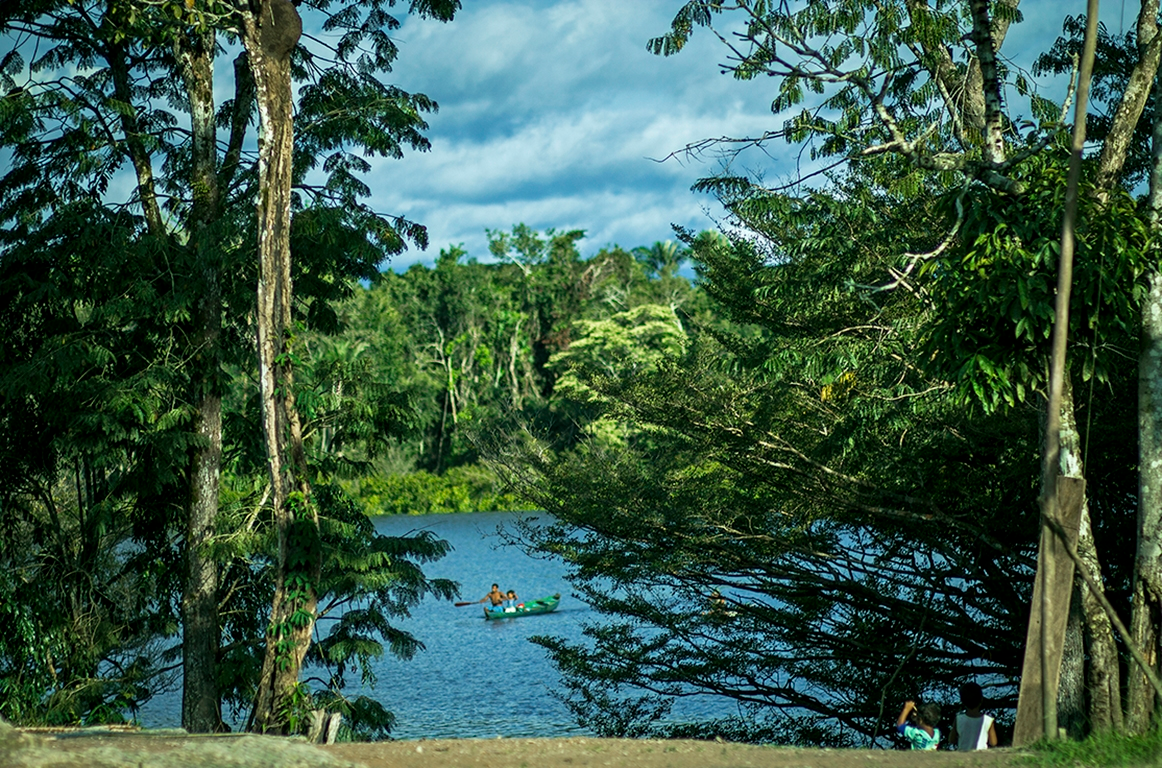
It’s generally known that protected areas like forests, water ecosystems, and biodiversity, in general, are essential. The demands and efforts for preserving natural areas are traced back a long time ago, affirming the priority for nations to commit to sustainable development that respects the ecosystem’s resilience worldwide. How is the protection of natural areas related to these efforts from nations and governments, and how this goes beyond crossing a line around these resources?

Amazon Rio Reserve. A 'RPDS' located in the heart of the Amazon Rainforest, on the banks of the Madeira River, with 15 traditional communities in its surroundings.

The first protected area ever registered in history was a Forest Reserve noticed in the Caribbean Islands of Trinidad and Tobago in the XVIII century. Afterward, in 1872, Yellowstone National Park (on the left) was homologated in the USA. This accomplishment later influenced the creation of other national parks in countries like Mexico, Argentina, and Brazil, with the Itatiaia National Park.
Following the establishment of the International Union for Conservation of Nature in 1948, there was an urge to determine guidance and a pattern to be followed for conserving and managing these areas. This urge contributed for Brazil to create its system of conservation of natural areas. The National System of Conservation Units (in Portuguese, SNUC) was made law in 2000, creating 12 main categories of Conservation Units and some specific ones, as in the case of AmaGroup’s reserve in the Amazon Forest.
SNUC is managed in three spheres: municipal, state, and federal, and among its goals are the contribution to conserving biological species variety, protecting extinction-threatened species, promoting sustainable development from natural resources, restoring degraded lands, favoring education, and many more.
With SNUC the conservation units were defined as: “territorial space and its environmental resources, including jurisdictional waters, with relevant natural characteristics, legally established by the Government, with conservation objectives and defined limits, under a special administration regime, to which adequate guarantees of protection apply;”. Referring to two modalities, the conservation units are allocated into two categories: the Integral Protection Unit, wherein only indirect use of the land is allowed, and the Sustainable Development Unit which permits the sustainable management of resources. For the integral protection, it’s found the following:
I - Ecological Station; Photograph: Ratones River and the Ecological Station (ESEC) Carijós, by Rico Bach

Aims to preserve nature and conduct scientific research. Public visitation is forbidden, except for educational purposes visitation. The main activities allowed in this category are measures that target the restoration of modified ecosystems, species management for biological diversity preservation, and the collection of ecosystem components for academic purposes. II - Biological Reserve; Photograph: Perobas Biological Reserve (Rebio)

Aims to fully preserve the biota and other natural attributes existing within its boundaries, without direct human interference or environmental modifications. Public visitation is forbidden and the only activity allowed is scientific research.
III - National/State/Municipal Park; Photograph: IlhaBela State Park

Holds as its basic objective the preservation of natural ecosystems of great ecological relevance and scenic beauty. Public visitation is allowed under conditions from the Management Plan of the area and scientific research depends on legal authorization.
IV - Natural Monument; Photograph: Natural Monument (MoNa) Pedra do Baú ('Chest Rock') by Reinaldo Opice

Its basic objective is to preserve rare, unique natural sites or sites of great scenic beauty. The Natural Monument may consist of private areas, and visitation is allowed under conditions punctuated by its Forest Management plan.
V - Wild Life Refuge Photograph: Rio Frades Refuge, by Marcelino Dias

Seeks to protect natural environments where conditions are ensured for the existence or reproduction of species or communities of local flora and fauna. Visitation is allowed but restricted, and academic research is permitted with legal preliminary authorization.
On the other hand, for Sustainable Use Units there are:
I - Environmental Protection Area;
Photograph: Caraá Protection Area

It’s endowed with abiotic, and biotic aesthetic, or cultural attributes especially important for the quality of life and well-being of human populations, Its basic objectives are to protect biological diversity, discipline the occupation process, and ensure the sustainability of the use of natural resources. Public visitation and research are allowed under State permission.
II - Area of Relevant Ecological Interest; Photograph: São Bernardo Area

It’s an area generally of small extension, with little or no human occupation, with extraordinary natural characteristics or which harbors rare specimens of the regional biota, and aims to maintain natural ecosystems. Subject to constitutional limits, rules, and restrictions may be established for the use of private property located in an Area of Relevant Ecological Interest.
III - National/State Forest; Photograph: Tapajós National Forest

It’s an area with a forest cover of predominantly native species and has as its basic objective the sustainable multiple uses of forest resources and scientific research, with emphasis on methods for sustainable exploitation of forests. In the National Forests, the permanence of the traditional populations that inhabit them is allowed. Visitation is allowed and research is stimulated. When private properties are located within their limits, they must be expropriated.
IV - Extractive Reserve; Photograph: Rio Branco-Jauaperi, by Maurício de Paiva

The Extractive Reserve is an area used by traditional extractive populations, whose subsistence is based on extractivism and, complementarily, on subsistence agriculture. Its basic objectives are to protect the livelihoods and culture of these populations and to ensure the sustainable use of natural resources. Private properties found within their limits must be dispossessed. Research and public visitation are allowed under authorization from local communities in the Forest Management plan. Hunting and exploiting mineral resources is forbidden, and wood products management and commercialization are allowed only if established under sustainable practices foreseen in the Forest Management Plan.
V - Fauna Reserve; Photograph: Babitonga Bay Fauna Reserve

It’s a natural area with animal populations of native species, terrestrial or aquatic, resident or migratory, suitable for technical-scientific studies on the sustainable economic management of wildlife resources. Visitation is allowed and hunting is expressively forbidden.
VI - Sustainable Development Reserve; Photograph: Uatumã Reserve, by: idesam

It’s a natural area that is home to traditional populations, whose existence is based on sustainable systems of exploitation of natural resources, developed over generations and adapted to local ecological conditions, and which play a fundamental role in the protection of nature and the maintenance of biological diversity. It ensures the conditions and means necessary for the reproduction and improvement of the means and quality of life and the exploitation of natural resources of traditional populations, as well as valorizes, conserves, and improves the knowledge and techniques of environmental management developed by these populations. Public visitation is incentivized and so is research. The management of natural components of the forest is allowed under a Forest Management plan.
VII - Private Natural Heritage Reserve Photograph: Barba Negra Reserve, by Celulose Riograndense

It’s a private area, recorded in perpetuity, with the aim of conserving biological diversity. In this category, the activities allowed are academic research and public visitation for touristic, recreational, and educational purposes
With all categories explained out, in which one could Amazon Rio (AmaGroup’s reserve) be allocated?
Amazon Rio is considered a Private Sustainable Development Reserve, under the Amazonas State Government legislation wherein the State System of Conservation Units (in Portuguese, SEUC) was established by the Complementary Law 53/2007.

A Private Sustainable Development Reserve, under the terms of the aforementioned law, is a private area, voluntarily created by the owner and recorded in perpetuity. It may or may not contain a user population, with the objective of promoting conservation and sustainable development through the direct use of natural resources.
Alongside the ordinary Sustainable Development Reserves, the private ones - RPDS’s (as called in Portuguese) - are fundamental to a sustainable development agenda, to which private enterprises commit to a governmental and international agenda for conserving the forests, preserving the biodiversity, and promoting human well-being against climate change. And this is the importance of a Private Reserve in the Amazon Rainforest, a highly-threatened region full of biodiversity richness, ancient knowledge, and people, wherein the CU’s find management plans that help to generate income from standing forests whereas conserving it for future generations. It’s a new economy framing. Regenerative, and conservationist, grounded on public-private efforts.
Amazon Rio was homologated in 2013 by EBCF - Brazilian Rainforest Conservation Company, the founder-company of AmaGroup, alongside the Amazonas State Government. This initiative strengthened the efforts in the region for sustainable development of the rainforest based on a strongly articulated bioeconomy development.
Amazon Rio has brought together companies, educational centers, and university projects to the reserve, and has been conducting the reserve management, counting on the active participation of traditional and indigenous communities, to make it an open lab in innovation and sustainability for the world.
Under the legislation terms for Conservation Units, AmaGroup has been developing many projects that daily impact around 450 families, 1000 children, and over 3000 people. For example, there are:
REDD+ Carbon Project

The Carbon Project in the reserve is the main contribution to the climate crisis mitigation, avoiding deforestation, preserving ecosystem services, and being validated to generate 2.2 million tons of CO2 credits that finance social assistance and development in the 15 communities living around the reserve.
Complementary Education Program in the Community

The real ESG goes beyond the land, its forest, and its resources. It also must fundamentally highlight the people in the region, its livelihood, and its needs. Understanding the lack of infrastructure and social development in the Northern region of the country, educational grounds are weak in the communities. In partnership with ‘Alicerce’ education company, EBCF implemented the Complementary Education Course in the “Democracia” Community, targeting to develop talents based on the recovery of the educational basis of the teenagers and children of the community. This partnership aims to expand the program for all communities surrounding the reserve.
Family Health Program and Clean, Piped Water For All Programs

These programs validate the importance of creating conditions for families to evolve, to be assisted in situations of clean water scarcity or total lack, and have assured basic conditions for their livelihood. These programs donated to the communities water filters for the families and also installed a piped-water network, besides reactivating a cartesian well deactivated for 12 years. Furthermore, community members received medical aid kits to assist the communities and perform symptoms evaluation, etc. These initiatives counted on the partnership with Sony Music and the Health Municipal Secretary of the Amazonas State to put out such great results.
Connectivity in the community
Consisted in the installation of internet infrastructure in “Jatuarana” Community, providing communication and connectivity means for the entire population
Advisory Board of Amazon Rion RPDS

A true ESG commitment forging real impact framed in the SDGs agenda not only assists communities but empowers them, converting them into agents of change and protagonists of their own reality. The Advisory Board was created to affirm and maintain the closest proximity between AmaGroup and the communities interests, having in mind their rights over the land, their knowledge, and their importance as guardians of this great human patrimony that is the rainforest.
Jatuarana Biojewelry
Another example of the effort that empowers the community members and creates conditions for the economic development of the families. This project consisted of the supply of equipment, structure, training, and qualification for women from the Jatuarana Community, with the objective of stimulating and making possible the production of necklaces, earrings, and bracelets with materials collected from the Brazilian biodiversity. The goal is to expand this project to other communities around the reserve.
and many more.

Under these terms, it’s clear that Conservation units are very important to the maintenance of life on earth, climate change mitigation, preservation of biodiversity, maintenance of ecosystem services, economic development provision, and many more. Public-private partnerships alongside communities and universities demonstrate a great potential to use the Amazon rainforest as an open lab for developing the entire world, and this is what AmaGroup is building.
An ESG organization must commit to a true consistent agenda to build a new economy, far from marketing and legal maneuvers, investing, and articulating impactful projects to be deeply compromised to a green future. Become an agent of impact. Join our mission, get to know AmaGroup efforts, and be part of our community on Discord (global) and WhatsApp (Brasil). AMALAND is coming with great rewards for initial buyers. Subscribe NOW to the waiting list!
Be part of this journey











